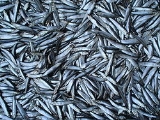
Docosanoid
Encyclopedia
In biochemistry, Docosanoids are signaling molecules
made by oxygenation
of twenty-two-carbon essential fatty acids, (EFAs), especially Docosahexaenoic acid
(DHA). They include some resolvins
and the docosatrienes.
Docosatrienes contain conjugated triene structures generated from DHA as a defining feature.
is formed in retinal pigment epithelial cells when they are confronted with oxidative stress, in the brain during experimental stroke, and in the human brain from Alzheimer's disease patients as well as in human brain cells in culture. Neuroprotectin D1 displays potent anti-inflammatory and neuroprotective bioactivity.
These substances are extremely potent. Neuroprotectin D1 and the 17S series resolvins are potent into the picomolar range.
Neurofuran
s are docosanoids formed nonenzymatically by free radical mediated peroxidation of DHA.
and Cytochrome P450 oxidase
act upon adrenic acid
to produce dihomoprostaglandins
and dihomo-EET
s, respectively.
Lipid signaling
Lipid signaling, broadly defined, refers to any biological signaling event involving a lipid messenger that binds a protein target, such as a receptor, kinase or phosphatase, which in turn mediate the effects of these lipids on specific cellular responses...
made by oxygenation
Oxygenation
Oxygenation may refer to:* Oxygenation , a measurement of dissolved oxygen concentration in soil or water* Oxygenation , the process by which concentrations of oxygen increase within a tissue...
of twenty-two-carbon essential fatty acids, (EFAs), especially Docosahexaenoic acid
Docosahexaenoic acid
Docosahexaenoic acid is an omega-3 fatty acid that is a primary structural component of the human brain and retina. In chemical structure, DHA is a carboxylic acid with a 22-carbon chain and six cis double bonds; the first double bond is located at the third carbon from the omega end...
(DHA). They include some resolvins
Resolvins
Resolvins are compounds that are made by the human body from the omega-3 fatty acids eicosapentaenoic acid and docosahexaenoic acid . They are produced by the COX-2 pathway especially in the presence of aspirin...
and the docosatrienes.
Docosatrienes contain conjugated triene structures generated from DHA as a defining feature.
Neuroprotectins
The protectins comprise docosatrienes and resolvins of the D series that are both neuroprotective and anti-inflammatory. Neuroprotectin D1Neuroprotectin
Neuroprotectin D1 is a docosanoid derived from the polyunsaturated fatty acid docosahexaenoic acid , which is a component of fish oil and the most important omega-3 PUFA. NPD1 exerts potent anti-inflammatory and anti-apoptotic bioactivity at nanomolar concentrations in a variety of experimental...
is formed in retinal pigment epithelial cells when they are confronted with oxidative stress, in the brain during experimental stroke, and in the human brain from Alzheimer's disease patients as well as in human brain cells in culture. Neuroprotectin D1 displays potent anti-inflammatory and neuroprotective bioactivity.
These substances are extremely potent. Neuroprotectin D1 and the 17S series resolvins are potent into the picomolar range.
Neurofuran
Neurofuran
Neurofurans are 22-carbon compounds formed nonenzymatically by free radical mediated peroxidation of docosahexaenoic acid , an ω-3 essential fatty acid. The neurofurans are similar to the isofurans and are formed under similar conditions of oxidative stress, containing a substituted...
s are docosanoids formed nonenzymatically by free radical mediated peroxidation of DHA.
Others
CyclooxygenaseCyclooxygenase
Cyclooxygenase is an enzyme that is responsible for formation of important biological mediators called prostanoids, including prostaglandins, prostacyclin and thromboxane. Pharmacological inhibition of COX can provide relief from the symptoms of inflammation and pain...
and Cytochrome P450 oxidase
Cytochrome P450 oxidase
The cytochrome P450 superfamily is a large and diverse group of enzymes. The function of most CYP enzymes is to catalyze the oxidation of organic substances. The substrates of CYP enzymes include metabolic intermediates such as lipids and steroidal hormones, as well as xenobiotic substances...
act upon adrenic acid
Docosatetraenoic acid
Docosatetraenoic acid designates any straight chain 22:4 fatty acid. One isomer is of particular interest:...
to produce dihomoprostaglandins
and dihomo-EET
Epoxyeicosatrienoic acid
The Epoxyeicosatrienoic acids or EETs are signaling molecules formed by the action of Cytochrome P450 epoxygenase on 20-carbon essential fatty acids, such as arachidonic acid, from which it is produced by the enzyme epoxygenase....
s, respectively.

